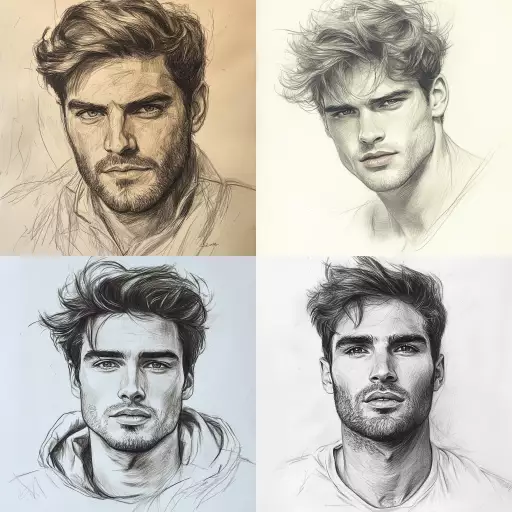Explore the Best AI Image Gallery

AI: The Artistic Alchemist - Reshaping the Graphic Design Landscape
The realm of graphic design is undergoing a profound transformation, fueled by the rapid advancements in artificial intelligence (AI). This innovative technology is not merely automating tasks but is actively shaping the creative process itself, blurring the lines between human ingenuity and machine intelligence. From generating stunning visuals to streamlining workflows, AI is poised to revolutionize how designers conceive, create, and deliver compelling visual content.
Demystifying AI in Graphic Design
AI-powered tools are now capable of performing a wide array of graphic design tasks, including:
- Logo Design: Generate unique and memorable logos based on specific brand guidelines and target audiences.
- Image Editing and Manipulation: Enhance images, remove unwanted elements, and apply artistic effects with remarkable precision.
- Typography Selection: Recommend appropriate font pairings that complement the design aesthetic and message.
- Layout and Composition: Suggest optimal arrangements of elements to create visually appealing and balanced compositions.
- Content Creation: Generate textual content for website copy, social media captions, or marketing materials, tailored to specific themes and tones.
Unlocking the Potential: Use Cases Across Industries
The versatility of AI in graphic design extends across diverse industries:
- Marketing and Advertising: Create eye-catching marketing collateral, social media graphics, and advertising campaigns that resonate with target demographics.
- Branding and Identity Design: Develop cohesive brand identities, encompassing logos, color palettes, typography, and visual elements that reflect the companys values and mission.
- Web and Mobile Design: Generate user interfaces (UI) and user experiences (UX) that are both aesthetically pleasing and functionally efficient.
- Publishing and Print Media: Design layouts for magazines, books, brochures, and other print materials with professional-grade quality.
Navigating the Ethical Landscape
While AI presents immense opportunities, its crucial to address the ethical considerations associated with its use in graphic design:
- Copyright and Intellectual Property: Ensure that AI-generated content respects existing copyright laws and intellectual property rights.
- Bias and Representation: Mitigate potential biases in AI algorithms that could result in unfair or discriminatory representations in visual content.
- Transparency and Accountability: Promote transparency in the use of AI, making it clear when human intervention is involved in the creative process.
Future Trends: Where Will AI Take Us?
The future of AI in graphic design holds exciting possibilities:
- Personalized Design Experiences: AI will enable highly personalized designs tailored to individual user preferences and needs.
- Real-Time Collaboration:** Designers and clients can collaborate seamlessly in real time, using AI to generate and iterate on design concepts collaboratively.
- Predictive Design:** AI algorithms will analyze data to predict future design trends and consumer preferences, informing creative decision-making.
Conclusion
AI is undoubtedly transforming the graphic design landscape, empowering designers with new tools and possibilities. By embracing this transformative technology responsibly and ethically, we can unlock its full potential to create innovative, engaging, and impactful visual experiences.












](https://images.ai-img.art/thumbnails/150/157712d76865d557120f9baf988de3d0525225295a2789c89bf2c4a5a96a03d1.webp)
![**Representation: A dog acting as a private tutor to a child. The dog holds a ruler in its paw and stands at the blackboard to explain a dog diagram to the child. Graphic style: Line drawing, cartoon style, influenced by Franco-Belgian comics, thick black lines, simplified design, vector, black and white only, in the style of Keith Haring or the French comic strip "Alinéa". [IMPORTANT]: A single continuous line extending from one side of the image to the other, minimalist, strong outlines, line drawing, without lifting the hand, ultra-simplified, no shading, entirely white image, drawing created in the center of a sheet of paper. --ar 16:5** - Variations (Strong) by <@627984126871470085> (fast)](https://images.ai-img.art/thumbnails/150/f4e034998ccd869d8a061fd12017514fcd92210eb33d4222dc9b54716223f4dd.webp)

](https://images.ai-img.art/thumbnails/150/9d51c5e673b4f2068b7b01abc35425a06f173b76303adf9ad29ca14302c25b18.webp)







![**Representation: A dog acting as a private tutor to a child. The dog holds a ruler in its paw and stands at the blackboard to explain a dog diagram to the child. Graphic style: Line drawing, cartoon style, influenced by Franco-Belgian comics, thick black lines, simplified design, vector, black and white only, in the style of Keith Haring or the French comic strip "Alinéa". [IMPORTANT]: A single continuous line extending from one side of the image to the other, minimalist, strong outlines, line drawing, without lifting the hand, ultra-simplified, no shading, entirely white image, drawing created in the center of a sheet of paper. --ar 16:5** - <@627984126871470085> (fast)](https://images.ai-img.art/thumbnails/150/7a854648a81e51241dcca8d24dd6e3bfcf07ad1df51baf401c9b729f4cf411fa.webp)

















![**Representation: A teenager smiling while thinking about a friendly dog, a comic-style thought bubble with a friendly dog inside. Graphic style: Line drawing, cartoon style, influenced by Franco-Belgian comics, thick black lines, simplified design, vector, black and white only, in the style of Keith Haring or the French comic strip "Alinéa". [IMPORTANT]: A single continuous line extending from one side of the image to the other, minimalist, strong outlines, line drawing, without lifting the hand, ultra-simplified, no shading, entirely white image, drawing created in the center of a sheet of paper. --ar 16:5** - <@627984126871470085> (fast)](https://images.ai-img.art/thumbnails/150/6fc850f638e3dee0c4b121acecad2c8419e02bdeac7f871d625f1003c1c3abe1.webp)
](https://images.ai-img.art/thumbnails/150/51c93500396faff4e7fa8b42bc68033067b16b2230e3496e95c482a581ff0fe9.webp)

